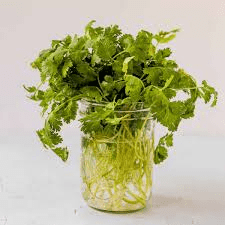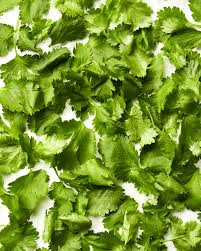Cilantro is a fragrant herb that adds a fresh and zesty flavor to many dishes, especially in Mexican, Asian, and Indian cuisines. It is also known for its health benefits, such as aiding digestion, fighting infections, and lowering blood pressure. But how do you store cilantro so that it stays fresh and potent for as long as possible?
In this article, I will show you how to store cilantro in different ways and conditions, and how to avoid common mistakes that can ruin your cilantro. I will also give you some tips on how to select, clean, and use cilantro in various recipes. By following this guide, you will be able to enjoy cilantro in all its glory, and make the most of this amazing herb.
How to Select Cilantro
Before you store cilantro, you need to choose the best quality cilantro. Here are some things to look for when buying cilantro:
1. Look for bright green and crisp leaves. Avoid cilantro that has yellow, brown, or wilted leaves, as this indicates that it is old or damaged. Fresh cilantro should have a vibrant green color and a crisp texture when you touch it.
2. Look for firm and intact stems. Avoid cilantro that has soft, hollow, or broken stems, as this reduces the flavor and quality of the cilantro. Fresh cilantro should have firm and solid stems that are easy to cut and use.
3. Look for a pleasant and strong aroma. Avoid cilantro that has a weak, sour, or musty smell, as this means that it is stale or spoiled. Fresh cilantro should have a pleasant and strong aroma that is similar to citrus or lemon.
How to Store Fresh Cilantro in the Refrigerator

The best way to store fresh cilantro is to keep it in the refrigerator, where it can last for up to two weeks. Here are the steps to store fresh cilantro in the refrigerator:
1. Rinse the cilantro under cold running water. Cilantro is often grown in sandy soil, so it is important to wash it thoroughly before storing it. Rinse the cilantro under cold running water and gently shake off any excess water. Do not soak the cilantro in water, as this can cause it to lose its flavor and nutrients.
2. Pat the cilantro dry with a paper towel. The cilantro should be dry when stored in the refrigerator, as moisture can cause it to rot faster. Use a paper towel and gently pat the cilantro dry. Do not rub or squeeze the cilantro, as this can damage the leaves and stems.
3. Trim the bottom of the stems. Use a sharp knife or scissors and cut off about an inch from the bottom of the stems. This will expose the fresh part of the stems and help them absorb water while stored.
4. Fill a glass jar or a cup with water. Use a glass jar or a cup that is tall enough to hold the cilantro stems. Fill it with about two inches of water. Do not use too much water, as this can drown the cilantro and cause it to rot.
5. Place the cilantro in the jar or cup. Insert the cilantro stems into the water, making sure that the leaves are above the water level. Do not pack the cilantro too tightly, as this can reduce the air circulation and cause it to wilt.
6. Cover the cilantro with a plastic bag. Use a clean plastic bag and loosely cover the cilantro and the mouth of the jar or cup. This will create a mini greenhouse effect and keep the cilantro fresh and moist. Do not seal the bag, as this can trap the ethylene gas that the cilantro produces and cause it to spoil faster.
7. Store the cilantro in the refrigerator. Place the jar or cup of cilantro in the refrigerator, preferably in the door or the front, where it is less cold and more visible. Avoid placing the cilantro near the back or the bottom of the refrigerator, where it is colder and more likely to freeze. Also avoid placing the cilantro near fruits or vegetables that produce a lot of ethylene gas, such as apples, bananas, or tomatoes, as this can speed up the ripening and rotting process of the cilantro.
How to Store Fresh Cilantro in the Freezer

Another way to store fresh cilantro is to freeze it, where it can last for up to six months. Here are the steps to store fresh cilantro in the freezer:
1. Wash and dry the cilantro. Follow the same steps as above to wash and dry the cilantro before freezing it. Make sure the cilantro is completely dry, as any moisture can cause freezer burn and affect the flavor and texture of the cilantro.
2. Chop the cilantro. Use a sharp knife or scissors and chop the cilantro into small pieces. You can chop the leaves and stems together, or separate them if you prefer. Chopping the cilantro will make it easier to use and store in the freezer.
3. Spread the cilantro on a baking sheet. Use a baking sheet that fits in your freezer and line it with parchment paper or wax paper. Spread the chopped cilantro in a single layer on the baking sheet, leaving some space between the pieces. This will prevent the cilantro from clumping together and freezing into a solid mass.
4. Freeze the cilantro for an hour. Place the baking sheet in the freezer and freeze the cilantro for about an hour, or until it is firm and frozen. Do not freeze the cilantro for too long, as this can reduce its quality and flavor.
5. Transfer the cilantro to a freezer bag or container. Use a freezer-safe bag or container and label it with the date and the name of the herb. Transfer the frozen cilantro pieces to the bag or container and squeeze out as much air as possible. Seal the bag or container tightly and store it in the freezer.
6. Use the cilantro as needed. When you need to use the cilantro, simply take out the amount you need and add it directly to your dish. There is no need to thaw the cilantro, as it will wilt and lose its flavor. You can use frozen cilantro in cooked dishes, such as soups, stews, or curries, but not in raw or uncooked dishes, such as salads, dressings, or salsas.
Read Also: Fluffy Cat Breeds Description and Complete Care Guide
How to Store Dried Cilantro

The third way to store cilantro is to dry it, where it can last for up to a year. Here are the steps to store dried cilantro:
1. Wash and dry the cilantro. Follow the same steps as above to wash and dry the cilantro before drying it. Make sure the cilantro is completely dry, as any moisture can cause mold and spoilage.
2. Remove the leaves from the stems. Use your fingers or a knife and remove the leaves from the stems. Discard the stems or save them for another use, such as making broth or compost. Drying the leaves separately will speed up the drying process and preserve the flavor of the cilantro.
3. Spread the leaves on a baking sheet. Use a baking sheet that fits in your oven and line it with parchment paper or wax paper. Spread the cilantro leaves in a single layer on the baking sheet, leaving some space between the leaves. This will allow the air to circulate and dry the leaves evenly.
4. Dry the leaves in the oven. Preheat your oven to the lowest temperature setting, usually around 170 F (77 C). Place the baking sheet in the oven and dry the leaves for about two hours, or until they are crisp and brittle. Check the leaves every 15 minutes and rotate the baking sheet if needed. Do not over-dry the leaves, as this can burn them and ruin their flavor.
5. Cool and store the leaves. Remove the baking sheet from the oven and let the leaves cool completely. Then, use your fingers or a mortar and pestle to crush the leaves into smaller pieces. Transfer the dried cilantro to an airtight container or jar and label it with the date and the name of the herb. Store the container or jar in a cool, dry, and dark place, such as a pantry, a cupboard, or a drawer.
Read Also: How to Farm and Care for Haddock Fish (Melanogrammus aeglefinus)
How to Use Cilantro in Recipes
Now that you know how to store cilantro, you may wonder how to use it in recipes. Cilantro is a very versatile herb that can be used in many ways and cuisines. Here are some tips and ideas on how to use cilantro in recipes:
1. Adjust the amount of cilantro according to your taste. There is no fixed rule on how much cilantro to use in a recipe, as it depends on your personal preference and the type of dish. Some people love cilantro and use it generously, while others dislike it or are allergic to it. You can also vary the amount of cilantro depending on the form and freshness of the cilantro, as fresh cilantro has a stronger flavor than dried cilantro. A good rule of thumb is to start with a small amount of cilantro, and add more as needed, until you reach the desired flavor.
2. Add the cilantro at the right time. Cilantro is a delicate herb that can lose its flavor and color if cooked for too long or at a high temperature. To preserve its freshness and aroma, you should add the cilantro at the end of the cooking process, or just before serving. You can also garnish your dish with some fresh cilantro leaves for extra flavor and presentation.
3. Use the cilantro in different dishes. Cilantro can be used in a variety of dishes, from soups and salads to curries and tacos. You can also use cilantro to make sauces, dips, dressings, or pestos, by blending it with other ingredients, such as yogurt, lime, garlic, or nuts. Here are some examples of dishes that use cilantro:
i. Chicken Tortilla Soup: A hearty and spicy soup made with chicken, tomatoes, corn, beans, and spices, topped with cheese, sour cream, avocado, and cilantro.
ii. Thai Green Curry: A fragrant and creamy curry made with coconut milk, green curry paste, chicken, vegetables, and cilantro, served with rice or noodles.
iii. Cilantro Lime Rice: A simple and tasty side dish made with rice, lime juice, cilantro, and salt, perfect for pairing with Mexican or Asian dishes.
iv. Cilantro Lime Dressing: A tangy and refreshing dressing made with cilantro, lime juice, olive oil, honey, garlic, and salt, great for drizzling over salads, bowls, or wraps.
In conclusion Cilantro is a wonderful herb that can add a lot of flavor and health benefits to your dishes. But to enjoy it fully, you need to store it properly and use it before it goes bad. I hope this blog post has helped you learn how to store cilantro, how to clean and chop it, and how to use it in recipes.
If you have any questions, comments, or tips on how to store cilantro, feel free to share them in the comment section below. And if you liked this blog post, please share it with your friends and family.
Read Also: Everything You Need to Know About Hermit Crab
